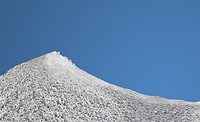Sealants 101


Sealants are broadly used in a variety of commercial and residential
applications. Common sealants include silicones, acrylics, urethanes, butyls
and other polymeric types. Various formulations have been developed over the
years that meet performance specifications as mandated by building codes, as
well as per the specific and unique needs of the end user.
The Freedonia Group Inc., a Cleveland-based market-research firm, projects U.S. sealant
and caulk demand to rise 3.4% per year over the 2006-2011 period to 3.0 billion
pounds. Sealants find use in a range of applications, including construction,
automotive and aerospace markets. Improving activity in key end-use industries,
particularly the motor vehicle, aerospace and nonresidential construction
sectors, will be the likely cause of this increase.
In value terms, the company expects demand to grow 4.3% annually through 2011
to $7.5 billion, supported by a continued shift in the product mix toward
better performing and higher value formulations. Silicone sealant and caulk demand
is forecast to advance 3.9% annually between 2006 and 2011 - the fastest pace
of all the product segments - to $775 million. Expanding use will be
based on silicone’s excellent weatherability and longevity, as well as wide
temperature range.
The construction market will continue to dominate sealant and caulk demand in
2011, with demand of 1.5 billion pounds based on projected annual gains of 2.9%
from 2006. Advances will be supported by strong activity in the
nonresidential and nonbuilding sectors.
The motor vehicle and aerospace and other transportation sectors are expected
to offer the best opportunities for sealants and caulks through 2011, supported
by recovering production of both automobiles and aerospace equipment.
The Function of Sealants
Sealants are generally used as a barrier or a means of protection. In this way, sealants are used to exclude dust, dirt, moisture and chemicals, or to contain a liquid or gas. They are also often used as a coating to protect a surface or an article. They can eliminate noise and vibration, improve appearance, and perform a joining function. Sealants can also be used as electrical or thermal insulators and fire barriers, and they may also be used for smoothing or filleting. Indeed, sealants are often called upon to perform several of these functions at once.No matter what the application, a sealant has three basic functions.
- It fills a gap between two or more substrates.
- It forms a barrier through the physical properties of the sealant itself and by adhesion to the substrate.
- It maintains sealing properties for the expected lifetime, service conditions and environments.
Unlike adhesives, there are not many functional alternatives to the sealing process. Soldering or welding can perhaps be used as a sealant in certain instances, depending on the substrates and the relative movement that the substrates will see in service. However, the simplicity and reliability offered by organic elastomers usually make them the clear choice for performing these functions.
One- and Two-Component Sealants
Two-component sealants are composed of two parts - a base component and an activator component. The activator is typically added to the base component and mixed for a set period of time before application. Two-component sealants are typically packaged in separate buckets, while a one-component sealant is packaged in a cartridge. No special equipment is required to apply one-component sealants; two-components require bulk guns and mixing equipment to prepare and apply the sealant.
Photo courtesy of DAP.
Performance Properties
Important mechanical properties of sealants include elongation, compressibility, tensile strength, modulus of elasticity, tear resistance and fatigue resistance. Depending on the nature of the application, a sealant may require very little strength or great strength. The sealant must have sufficient mechanical characteristics to remain attached to substrates during service as well as to provide a barrier. The substrates could move considerably, requiring that the sealant expand and contract significantly without losing adhesion from the surface. Defining movement capability is a complex process. Temperature, rate of temperature change and joint configuration will influence the results.In some applications, strength may be more important than elasticity. Low-strength - or, more precisely, low tensile modulus - may be the most important factor in a situation where a sealant joins one or more weak surfaces. Tensile strength is needed primarily to avoid cohesive failure under stress and so as not to transfer stress between substrates, as is the case with most adhesives.
Modulus can sometimes predict the extension or compression characteristics of a sealant. In general, low-to-medium-modulus sealants are able to take significant movement without putting much stress on the sealant or the substrate materials. Some high-performance sealants are formulated for a higher movement capability than a joint is actually designed to accommodate. In fact, joints designed for about 25% extension/compression must often accommodate movement of 50% or more. Thus, higher performance sealants provide an added safety factor. A change in elasticity or hardness on aging may be an indication that further curing or degradation is taking place.
Compressive strength is the maximum compressive stress that a sealant can withstand without breaking down or experiencing excessive extrusion from the joint. Compression set is the inability of a sealant to return to its original dimension after being compressed. High compression set is usually caused by further curing or degradative crosslinking of the material while under compression. Compression set is undesirable in a joint that needs to expand and contract. Stress relaxation is a condition in which the stress decays as the strain remains constant. Some very-low-modulus sealants literally get pulled apart when held at low elongation.
Sealants may be exposed to scuffing and mechanical wear. Examples include the sealant used as an expansion joint in highways and the sealant used in preparing stone walkways. Thus, they must offer good abrasion, puncture and tear resistance. Flexible sealants, which are available in either chemical curing or non-curing types, exhibit varying degrees of tear resistance. Urethanes have the highest tear resistance.
Dynamic loads, shock, and rapid variations in stress can also cause seals to fail. Thus, the consideration of tough and flexible elastomeric sealants that can stretch and then return to their original length in a short time should be the first step in the selection process for joints designed for mechanical loads.
Adhesion is also an important factor in determining a sealant’s performance. The same rules of adhesion that apply to adhesives also apply to sealants. Adhesion is primarily affected by the physio-chemical interaction between the sealant material and the surface to which it is applied. However, in certain joints where there is great movement, strong adhesion of a sealant to a specific substrate may not be desirable. In these situations, the adhesive strength is stronger than the cohesive strength of the sealant, and the sealant may tear apart when it expands or contracts. This requires the sealant to be applied so that it does not adhere to all surfaces. To achieve this affect, a bond-breaker or release material at the bottom of the joint is generally used.
Conditions that will influence the adhesion of sealants include water exposure, temperature extremes, movement considerations and surface cleanliness. Often, a surface-conditioning process or a priming step is necessary to make a substrate compatible with a specific sealant.
Weatherability is defined as a sealant’s degree of resistance when exposed to heat, moisture, cold, solar radiation, etc. The degree of weatherability is determined by the base polymer and the nature of the additives in the sealant formulation. Generally, sealants are formulated for maximum resistance to a single element, such as moisture.
Often, this chemistry will lend its resistance to other elements as well.
In many situations, the appearance of the sealant is almost as important as its physical properties. Thus, most sealants are available in a variety of colors to match the environment in which they are used. Several questions must be considered when determining the appearance requirements of sealants.
- Does a sealant cause discoloration of surrounding areas initially or over a period of time?
- Does water runoff over the material cause unsightly residues?
- Does one product cause discoloration of another?
- Does the product itself change in appearance over time for any reason?
Sealants may also need to be compatible with a specific environment for certain applications. Examples of this may be a requirement for a sealant to have USDA or FDA acceptance because food or drugs are to be processed in the area near the sealant. It may happen that, in an installation such as a food processor or clean room, the sealant cannot outgas or liberate certain chemical components either during or after cure. Another end-use requirement could be that the sealant must meet certain fire-resistance properties to meet code requirements in housing construction or another area of use.
For more information and a list of sealant suppliers, visit www.adhesivesmag.com/GAD.
Sources: The Adhesive and Sealant Council, Inc.; www.SpecialChem.com.
Links
Looking for a reprint of this article?
From high-res PDFs to custom plaques, order your copy today!



